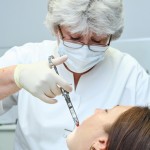
The aim of the study was to compare the anaesthetic efficacy of buccal infiltrations of 4% articaine with epinephrine (1:100,000) and 2% lidocaine with epinephrine (1:80,000) in achieving anaesthesia in maxillary permanent teeth with irreversible pulpitis.
Patients aged 16 years and over who presenting with irreversible pulpitis in one tooth and an asymptomatic vital tooth on the opposite side of the arch (to act as control ) were invited to participate in this double-blind randomized trial. Patients whose medical history contraindicated ephedrine or those with self-reported allergies were excluded.
Patients received 2.0 mL 4% articaine with 1:100,000 epinephrine( n=50) or 2% lidocaine with 1:80,000 epinephrine ( n=50) in the buccal sulcus adjacent to the tooth with pulpitis. The test tooth response was assessed using an electronic pulp tester before injection and every 2 minutes up to a maximum of 10 minutes thereafter. Successful pulp anaesthesia was considered to have occurred when no response was obtained to the maximum stimulation of the pulp tester during the test period, at which time treatment commenced. Treatment was regarded as being successfully completed when it was associated with no pain. The time to onset of successful pulp anaesthesia was recorded for each test tooth. Injection discomfort was recorded on standard 100-mm visual analog scale. Data were analyzed by the Chi-square and Student t tests.
They found
The percentages of pain-free treatment were similar in anterior, premolar, and molar teeth. There were no significant differences between the two local anaesthetics in the onset of pulpal anaesthesia and although articaine buccal injection was significantly more comfortable than lidocaine buccal injection both were associated with mild discomfort.
[table id=19 /]
The authors concluded
There was no significant difference in efficacy between 4% articaine with 1:100,000 epinephrine and 2% lidocaine with 1:80,000 epinephrine in achieving anaesthesia in maxillary teeth with irreversible pulpitis after buccal infiltration.
Related reviews
A meta-analysis of the efficacy and safety of articaine and lignocaine has been published ( Katyal 2010) and a commentary on this is available in the Evidence-based Dentistry Journal.
Katyal V. The efficacy and safety of articaine versus lignocaine in dental treatments: a meta-analysis. J Dent 2010; 38: 307–317. [PubMed Abstract]

Is it okay for a dentist to give double the dose of lidocaine and articaine 25 mins apart ?